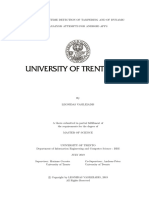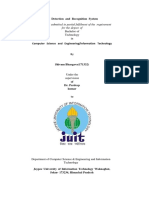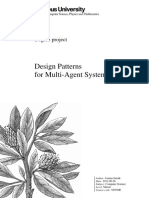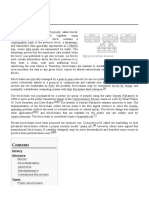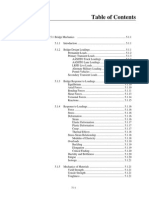Facial Recognition in Web Camera Using Deep Learning Under Google COLAB
Uploaded by
GRD JournalsFacial Recognition in Web Camera Using Deep Learning Under Google COLAB
Uploaded by
GRD JournalsGRD Journals- Global Research and Development Journal for Engineering | Volume 5 | Issue 7 | June 2020
ISSN- 2455-5703
Facial Recognition in Web Camera using Deep
Learning under Google COLAB
V. Neethidevan
Assistant Professor
Department of MCA
Mepco Schlenk Engineering College, Sivkaasi, India
Abstract
Face recognition is a method used to identify or verifying the identity of an individual using their face. Now a days systems
could be trained to check inputs in the form of photos, video, or in real-time. This kind of systems finds many applications Face
recognition is a popular and evergreen area for most research people. Over the period of time, many different algorithms were
introduced by the researchers across the globe. Identification of individual using facial image recognition is used in many real
time applications like allowing access to server secured locations, opening doors in working place and unlocking a laptop or
mobile. Nowadays anybody and add facial image recognition to their applications by simply invoking the suitable APIs provided
by several service providers like Amazon, IBM and Google. Still more challenges are available for the researchers like Aging,
Illumination, Face Direction and Facial Expressions that greatly affects the of the performance of the system. This paper deals
with recognizing the faces of various users with the help of webcam. When the user enters a class room, his image is captured
through a web cam and processed by the python code using cascade classifier used to detect each face in a given image. Then in
the recognition phase each phase in the image is compared with the existing image stored in the database.
Keywords- Image processing, Neural Network, Deep learning, Computer vision, Video analytics
I. INTRODUCTION
Face detection performance is a complex process ad it involves many issues to deal with the various inputs supplied to the
systems. Due to more updated systems in terms of hardware and software, need to develop a face recognition system to deals
with detecting and recognizing for the authentication system. The earlier manual process can’t not be used for system with more
number of users. After the successful implementation of CTV camera, need for a more accurate system to authenticate each and
every user whenever enters into the premises. It fins many applications and need for a more accurate system to avoid any
problems and threats to the organization.
A. Issues and Challenges in Face recognition
Face recognition has more issues in object recognition and computer vision. In our daily life many more biometric applications
are used for person authentication like, face recognition, finger print, iris detection etc. Each and every method has its own pros
and cons. To identify each person uniquely, face is considered as having more important one as it is used different applications
such as security, forensic investigation. It has more challenges with different facial expressions, pose variations, occlusion, aging
and resolution either in the frame of stationary object or video sequencing images. To improve better results, need to have face
synthesis, for improving accuracy and recognition rate on different face database like ORL, YALE, AR and LFW.
Facial recognition technology uses a database of photos, such as mugshots and driver's license photos to identify people in
security photos and videos. It uses biometrics to map facial features and help verify identity through key features of the face. The
most key feature is the geometry of a face such as the distance between a person's eyes and the distance from their forehead to
their chin. This then creates what is called a "facial signature." It is a mathematical formula that is then compared to a database of
known faces. Another major concern is the use of facial recognition for law enforcement purposes. Today, many police
departments across the world have begun utilizing the technology.
II. LITERATURE SURVEY
Identification of human faces by the unique characteristics or features of their face is known as Face recognition. Currently, Face
recognition technology is the fastest growing technology. Instead of using the traditional methods, this proposed system aims to
develop an automated system that records the student's attendance by using facial recognition technology for those who are
present during lecture hours.. Compared to existing system traditional attendance marking system, this system reduces the
workload of people and also saves times. System proposed in [1] has been implemented with 4 modules such as Image
Capturing, Segmentation of group photo and Face Detection, Face comparison and Recognition, Updating of Attendance in
database.
All rights reserved by www.grdjournals.com 53
Facial Recognition in Web Camera using Deep Learning under Google COLAB
(GRDJE/ Volume 5 / Issue 7 / 008)
It is indicated that M-FLDA can able to speed up the process of recognition and reduce the memory capacity. Finally,
the preliminary study of solving facial pose changes[2]. Face detection overlapping is one of the important works in face
detecting applications. In this paper DRLBP algorithm is used to identify overlapped faces detection. Initially the face is detected
from database images using DRLBP feature extraction. This feature extraction result is compared to our test images. Finally
classified method is used where we can classify and get the attendance validation result [3].
Facial image acquisition systems [4] produce low quality face images. This happens because the imaging conditions like
illumination, occlusion or noise might change among images. Now a days, the field of image processing has wide range
applications in biometric recognition, behavioral analysis, teleconferencing and video surveillance [5].
The model proposed in [6] focuses on how face recognition incorporated with Radio Frequency Identification (RFID)
detect the authorized students and counts as they get in and get out form the class room. Manual entering of attendance in
logbooks becomes a difficult task and it can be easily manipulated. The detected faces are matched against the reference faces in
the dataset and marked the attendance for the attendees. Finally the absentee lists are said aloud through voice conversion system
for confirmation. Secondly, the system is trained to classify the gender of the students present in the class[7].
III. STEPS IN FACE DETECTION
Note that face recognition is different from face detection:
Face Detection: Mainly it focuses on finding the faces in input image with various features that is the input for face
recognition algorithm.
Face Recognition: Once the facial images extracted, and various preprocessing steps applied like cropping, resizing and it is
the responsibility of the face recognition algorithm to find suitable features to describe the image so that it could recognize
as expected output image.
There are two modes possible for face recognition systems to operate:
Verification or authentication of a facial image: It is one to one mapping to compare input facial image and related to image
for which authentication is required.
Identification or facial recognition: In this mode it compares given input image with the given dataset, to find the user that
matches that face.
A. Face recognition Steps
Face recognition is often described as a process that first involves four steps; they are: face detection, face alignment, feature
extraction, and finally face recognition.
1) Face Detection. To locate the place in which one or more faces in the image and marked with a bounding box.
2) Face Alignment. Regularize the face to have exact match with the database.
3) Feature Extraction. Then, extract features used for the recognition task.
4) Face Recognition. Perform matching of the face against one or more known faces in a prepared database.
The following diagram shows overview of the process involved to recognize the input face.
Face Recognition Process flow
IV. HOW FACIAL RECOGNITION WORKS
Facial recognition is the process of identifying or verifying the identity of a person using their face. It captures, analyzes, and
compares patterns based on the person's facial details.
1) The face detection process is an essential step as it detects and locates human faces in images and videos.
All rights reserved by www.grdjournals.com 54
Facial Recognition in Web Camera using Deep Learning under Google COLAB
(GRDJE/ Volume 5 / Issue 7 / 008)
2) The face capture process transforms analogue information (a face) into a set of digital information (data) based on the
person's facial features.
3) The face match process verifies if two faces belong to the same person.
V. COMPARISON OF RESULTS
LDA-IR algorithm works best, presumably since it is the only algorithm that uses a parameterization that is optimized for those
protocols
Table 1: This table details the resulting correct acceptance rates (CAR) at false acceptance rate (FAR) 0.1% on the GBU database
The results on the BANCA database are reported in Table 2. Unlike on the GBU database, here the LDA-IR algorithm
performs much worse than the other algorithms, which could be because the meta-parameters of LDA-IR are not optimized for
this database, whereas, e.g., ISV was developed using BANCA algorithm.
Table 2: This table presents the verification results of experiments performed on the BANCA database. It includes the equal error rates (EER)
on the development set and the half total error rates (HTER) on the test set.
VI. EXPERIMENTAL WORK
The below procedure is used to perform face recognition using colab. Haar Cascade classifier is an effective object detection
approach which was proposed by Paul Viola and Michael Jones. This is basically a machine learning based approach where a
cascade function is trained from a lot of images both positive and negative. Based on the training it is then used to detect the
objects in the other images.
So how this works is they are huge individual .xml files with a lot of feature sets and each xml corresponds to a very
specific type of use case.
using the face_classifier which is an object loaded with haarcascade_frontalface_default.xml, we are using an inbuilt
function with it called the detectMultiScale.
This function will help us to find the features/locations of the new image. The way it does is, it will use all the features
from the face_classifierobject to detect the features of the new image.
from google.colab import files
file=files.upload()
test_image = cv2.imread('mepco.jpg')
# Converting to grayscale as opencv expects detector takes in input gray scale images
test_image_gray = cv2.cvtColor(test_image, cv2.COLOR_BGR2GRAY)
plt.imshow(test_image_gray, cmap='gray')
haar_cascade_face = cv2.CascadeClassifier('haarcascade_frontalface_alt2.xml')
faces_rects = haar_cascade_face.detectMultiScale(test_image_gray, scaleFactor = 1.2, minNeighbors =1);
# Let us print the no. of faces found
print('Faces found: ', len(faces_rects))
for (x,y,w,h) in faces_rects:
cv2.rectangle(test_image, (x, y), (x+w, y+h), (0, 255, 0), 2)
plt.imshow(test_image)
VII. CONCLUSION
Thus the face detection and recognition is done with various inputs are given in the form of input image or video from webcam
also. From the webcam video, individual images are given to the system and it uses the cascade classifier and do the
classification as shown in below. The input may be a single image or collection of images. Still it can able to detect and
bounding box is drawn in each and every image object with more accurate manner.
All rights reserved by www.grdjournals.com 55
Facial Recognition in Web Camera using Deep Learning under Google COLAB
(GRDJE/ Volume 5 / Issue 7 / 008)
Output that shows Face detection for given input image
REFERENCES
[1] J. W. S. D'Souza, S. Jothi and A. Chandrasekar, "Automated Attendance Marking and Management System by Facial Recognition Using Histogram," 2019
5th International Conference on Advanced Computing & Communication Systems (ICACCS), Coimbatore, India, 2019, pp. 66-69.
[2] L. Liying and H. Yue, "The Study of Entrance Guard & Check on Work Attendance System Based on Face Recognition," 2008 International Conference on
Computer Science and Information Technology, Singapore, 2008, pp. 44-47.
[3] N. Tamboli and M. M. Sardeshmukh, "Facial Based Attendance Monitoring System Using Discriminative Robust Local Binary Pattern," 2017 International
Conference on Computing, Communication, Control and Automation (ICCUBEA), Pune, 2017, pp. 1-5.
[4] L. Fung-Lung, M. Nycander-Barúa and P. Shiguihara-Juárez, "An Image Acquisition Method for Face Recognition and Implementation of an Automatic
Attendance System for Events," 2019 IEEE XXVI International Conference on Electronics, Electrical Engineering and Computing (INTERCON), Lima,
Peru, 2019, pp. 1-4.
[5] S. Hapani, N. Prabhu, N. Parakhiya and M. Paghdal, "Automated Attendance System Using Image Processing," 2018 Fourth International Conference on
Computing Communication Control and Automation (ICCUBEA), Pune, India, 2018, pp. 1-5.
[6] M. S. Akbar, P. Sarker, A. T. Mansoor, A. M. Al Ashray and J. Uddin, "Face Recognition and RFID Verified Attendance System," 2018 International
Conference on Computing, Electronics & Communications Engineering (iCCECE), Southend, United Kingdom, 2018, pp. 168-172.
[7] S. Poornima, N. Sripriya, B. Vijayalakshmi and P. Vishnupriya, "Attendance monitoring system using facial recognition with audio output and gender
classification," 2017 International Conference on Computer, Communication and Signal Processing (ICCCSP), Chennai, 2017, pp. 1-5.
[8] https://anyconnect.com/blog/facial-recognition-applications/
[9] https://towardsdatascience.com/computer-vision-detecting-objects-using-haar-cascade-classifier-4585472829a9.
All rights reserved by www.grdjournals.com 56
Facial Recognition in Web Camera using Deep Learning under Google COLAB
(GRDJE/ Volume 5 / Issue 7 / 008)
[10] Zhang, Yudong, Siyuan Lu, Xingxing Zhou, Ming Yang, Lenan Wu, Bin Liu, Preetha Phillips, and Shuihua Wang. "Comparison of machine learning
methods for stationary wavelet entropy-based multiple sclerosis detection: decision tree, k-nearest neighbors, and support vector machine." Simulation 92,
no. 9 (2016): 861-871.
[11] Al-Dabagh, Mustafa ZuhaerNayef, M. H. M. Alhabib, and F. H. Al-Mukhtar. "Face recognition system based on kernel discriminant analysis, k-nearest
neighbor and support vector machine." International Journal of Research and Engineering 5, no. 3 (2018): 335-338.
[12] K-nearest Altman, Naomi S. "An introduction to kernel and nearest-neighbor nonparametric regression." The American Statistician 46, no. 3 (1992): 175-
185. Support vector machine Gunn, Steve R. "Support vector machines for classification and regression." ISIS technical report 14, no. 1 (1998): 5-16.
[13] Image processing Schalkoff, Robert J. Digital image processing and computer vision. Vol. 286. New York: Wiley, 1989.
All rights reserved by www.grdjournals.com 57
You might also like
- Design of A NLP-empowered Finance Fraud Awareness Model The Anti-Fraud Chatbot For Fraud Detection and Fraud Classification As An InstanceNo ratings yetDesign of A NLP-empowered Finance Fraud Awareness Model The Anti-Fraud Chatbot For Fraud Detection and Fraud Classification As An Instance17 pages
- Module-3 Association Analysis: Data Mining Association Analysis: Basic Concepts and AlgorithmsNo ratings yetModule-3 Association Analysis: Data Mining Association Analysis: Basic Concepts and Algorithms34 pages
- Morgan Stanley - Introduction To Cryptocurrencies PDFNo ratings yetMorgan Stanley - Introduction To Cryptocurrencies PDF47 pages
- A Review On Unimodal and Multimodal Biometric SystemsNo ratings yetA Review On Unimodal and Multimodal Biometric Systems8 pages
- Tensorflow Object Detection Api Tutorial PDFNo ratings yetTensorflow Object Detection Api Tutorial PDF41 pages
- Authentication and Key Agreement Based On Anonymous Identity For Peer-To-Peer Cloud0% (1)Authentication and Key Agreement Based On Anonymous Identity For Peer-To-Peer Cloud7 pages
- 2021 - A Graph Neural Network Method For Distributed Anomaly Detection in IoT - Protogerou Et AlNo ratings yet2021 - A Graph Neural Network Method For Distributed Anomaly Detection in IoT - Protogerou Et Al18 pages
- AI-Based Proctoring System For Online Tests: Abstract100% (1)AI-Based Proctoring System For Online Tests: Abstract6 pages
- Blockchain Use Cases For The Telecommunications IndustryNo ratings yetBlockchain Use Cases For The Telecommunications Industry42 pages
- Cryptocurrencies and Market Efficiency: Investigate The Implications of Cryptocurrencies On Traditional Financial Markets and Their EfficiencyNo ratings yetCryptocurrencies and Market Efficiency: Investigate The Implications of Cryptocurrencies On Traditional Financial Markets and Their Efficiency16 pages
- Video Based Fight Detection Using Deep LearningNo ratings yetVideo Based Fight Detection Using Deep Learning52 pages
- License Number Recognition of A Vehicle Using MATLAB100% (1)License Number Recognition of A Vehicle Using MATLAB20 pages
- Design Patterns For Multi-Agent Systems: Degree ProjectNo ratings yetDesign Patterns For Multi-Agent Systems: Degree Project38 pages
- Secure Identification at Your Fingertips Building A Face Recognition System With Google ColabNo ratings yetSecure Identification at Your Fingertips Building A Face Recognition System With Google Colab7 pages
- Phishing Attack Prevention Using CryptographyNo ratings yetPhishing Attack Prevention Using Cryptography42 pages
- Blockchain Security: A Framework For Trust and AdoptionNo ratings yetBlockchain Security: A Framework For Trust and Adoption44 pages
- Real Time Bangladeshi License Plate Detection & Recognition: Submitted byNo ratings yetReal Time Bangladeshi License Plate Detection & Recognition: Submitted by25 pages
- Credit Card Fraud Detection Using Hidden Markov ModelNo ratings yetCredit Card Fraud Detection Using Hidden Markov Model23 pages
- Seminar Report On Biometric AuthenticationNo ratings yetSeminar Report On Biometric Authentication7 pages
- Theoretical and Practical Analysis On CNN, MTCNN and Caps-Net Base Face Recognition and Detection PDFNo ratings yetTheoretical and Practical Analysis On CNN, MTCNN and Caps-Net Base Face Recognition and Detection PDF35 pages
- Trade Lifecycle Management With TIBCO Business Events and TIBCO IprocessNo ratings yetTrade Lifecycle Management With TIBCO Business Events and TIBCO Iprocess27 pages
- 8/9/17 9:33 PM D:/CBCS/Matlab Codes/Bolzano.m 1 of 1: Screen Long ' (-1) . N' 'N'No ratings yet8/9/17 9:33 PM D:/CBCS/Matlab Codes/Bolzano.m 1 of 1: Screen Long ' (-1) . N' 'N'1 page
- Spammer Detection and Fake User Identification On Social NetworksNo ratings yetSpammer Detection and Fake User Identification On Social Networks7 pages
- Blockchain: A New Technology That Will Transform The Real Estate MarketNo ratings yetBlockchain: A New Technology That Will Transform The Real Estate Market74 pages
- A Comprehensive Survey On Pretrained Foundation ModelsNo ratings yetA Comprehensive Survey On Pretrained Foundation Models97 pages
- Vision-Face Recognition Attendance Monitoring System For Surveillance Using Deep Learning Technology and Computer VisionNo ratings yetVision-Face Recognition Attendance Monitoring System For Surveillance Using Deep Learning Technology and Computer Vision5 pages
- Preserving Privacy Against Side-Channel Leaks: Wen Ming Liu Lingyu WangNo ratings yetPreserving Privacy Against Side-Channel Leaks: Wen Ming Liu Lingyu Wang154 pages
- 2016 Big Data Analytics For Financial Sentiment Analysis in FinTech 20161115 PDFNo ratings yet2016 Big Data Analytics For Financial Sentiment Analysis in FinTech 20161115 PDF200 pages
- SOA-Based Enterprise Integration: A Step-by-Step Guide to Services-based ApplicationFrom EverandSOA-Based Enterprise Integration: A Step-by-Step Guide to Services-based ApplicationNo ratings yet
- Design and Analysis of Underground Circular & Rectangular Water Tank and Intze Water TankNo ratings yetDesign and Analysis of Underground Circular & Rectangular Water Tank and Intze Water Tank5 pages
- Effect of Various Lateral Load Resisting Systems On Buildings With Flat Slab SystemsNo ratings yetEffect of Various Lateral Load Resisting Systems On Buildings With Flat Slab Systems16 pages
- An Efficient Comparison Neural Network Methods To Evaluate Student PerformanceNo ratings yetAn Efficient Comparison Neural Network Methods To Evaluate Student Performance4 pages
- Optimization of Xanthan Gum Fermentation Utilizing Food WasteNo ratings yetOptimization of Xanthan Gum Fermentation Utilizing Food Waste11 pages
- Automatic Face Recognition Attendance System Using Python and OpenCv100% (1)Automatic Face Recognition Attendance System Using Python and OpenCv7 pages
- Evaluate The Performance of MongoDB NoSQL Database Using PythonNo ratings yetEvaluate The Performance of MongoDB NoSQL Database Using Python5 pages
- Proposing New Intelligence System For Tourism Management and Suggesting New Methods For Increasing Its SecurityNo ratings yetProposing New Intelligence System For Tourism Management and Suggesting New Methods For Increasing Its Security19 pages
- Design and Simulation of LNA Using Advanced Design Systems (ADS)No ratings yetDesign and Simulation of LNA Using Advanced Design Systems (ADS)6 pages
- MKTG3002 Digital and Social Media Marketing: Lectorial 1No ratings yetMKTG3002 Digital and Social Media Marketing: Lectorial 148 pages
- Chapter Three Chapter Three The Multiple Linear Regression (MLR)No ratings yetChapter Three Chapter Three The Multiple Linear Regression (MLR)50 pages
- Undersecretary: in View of The Preparations For The Upcoming School Year (SY) 2022-2023 School OpeningNo ratings yetUndersecretary: in View of The Preparations For The Upcoming School Year (SY) 2022-2023 School Opening2 pages
- Control CL Commands With Command Exit Programs - Part 1No ratings yetControl CL Commands With Command Exit Programs - Part 18 pages
- ANDUALEM DEMISSIE DEGU The Effect of Working Capital Management On The Profitability of Manufacturing Companies in Ethiopia100% (1)ANDUALEM DEMISSIE DEGU The Effect of Working Capital Management On The Profitability of Manufacturing Companies in Ethiopia78 pages
- IMPORTANT TOPICS - SCIENCE Class 10th (PRASHANT KIRAD) - Class - 10th - Most - Important - Topics (Prashant - Kirad)No ratings yetIMPORTANT TOPICS - SCIENCE Class 10th (PRASHANT KIRAD) - Class - 10th - Most - Important - Topics (Prashant - Kirad)5 pages
- 99.poultry Breeding and Multiplication Center OkNo ratings yet99.poultry Breeding and Multiplication Center Ok21 pages
- Design of A NLP-empowered Finance Fraud Awareness Model The Anti-Fraud Chatbot For Fraud Detection and Fraud Classification As An InstanceDesign of A NLP-empowered Finance Fraud Awareness Model The Anti-Fraud Chatbot For Fraud Detection and Fraud Classification As An Instance
- Module-3 Association Analysis: Data Mining Association Analysis: Basic Concepts and AlgorithmsModule-3 Association Analysis: Data Mining Association Analysis: Basic Concepts and Algorithms
- Morgan Stanley - Introduction To Cryptocurrencies PDFMorgan Stanley - Introduction To Cryptocurrencies PDF
- A Review On Unimodal and Multimodal Biometric SystemsA Review On Unimodal and Multimodal Biometric Systems
- Authentication and Key Agreement Based On Anonymous Identity For Peer-To-Peer CloudAuthentication and Key Agreement Based On Anonymous Identity For Peer-To-Peer Cloud
- 2021 - A Graph Neural Network Method For Distributed Anomaly Detection in IoT - Protogerou Et Al2021 - A Graph Neural Network Method For Distributed Anomaly Detection in IoT - Protogerou Et Al
- AI-Based Proctoring System For Online Tests: AbstractAI-Based Proctoring System For Online Tests: Abstract
- Blockchain Use Cases For The Telecommunications IndustryBlockchain Use Cases For The Telecommunications Industry
- Cryptocurrencies and Market Efficiency: Investigate The Implications of Cryptocurrencies On Traditional Financial Markets and Their EfficiencyCryptocurrencies and Market Efficiency: Investigate The Implications of Cryptocurrencies On Traditional Financial Markets and Their Efficiency
- License Number Recognition of A Vehicle Using MATLABLicense Number Recognition of A Vehicle Using MATLAB
- Design Patterns For Multi-Agent Systems: Degree ProjectDesign Patterns For Multi-Agent Systems: Degree Project
- Secure Identification at Your Fingertips Building A Face Recognition System With Google ColabSecure Identification at Your Fingertips Building A Face Recognition System With Google Colab
- Blockchain Security: A Framework For Trust and AdoptionBlockchain Security: A Framework For Trust and Adoption
- Real Time Bangladeshi License Plate Detection & Recognition: Submitted byReal Time Bangladeshi License Plate Detection & Recognition: Submitted by
- Credit Card Fraud Detection Using Hidden Markov ModelCredit Card Fraud Detection Using Hidden Markov Model
- Theoretical and Practical Analysis On CNN, MTCNN and Caps-Net Base Face Recognition and Detection PDFTheoretical and Practical Analysis On CNN, MTCNN and Caps-Net Base Face Recognition and Detection PDF
- Trade Lifecycle Management With TIBCO Business Events and TIBCO IprocessTrade Lifecycle Management With TIBCO Business Events and TIBCO Iprocess
- 8/9/17 9:33 PM D:/CBCS/Matlab Codes/Bolzano.m 1 of 1: Screen Long ' (-1) . N' 'N'8/9/17 9:33 PM D:/CBCS/Matlab Codes/Bolzano.m 1 of 1: Screen Long ' (-1) . N' 'N'
- Spammer Detection and Fake User Identification On Social NetworksSpammer Detection and Fake User Identification On Social Networks
- Blockchain: A New Technology That Will Transform The Real Estate MarketBlockchain: A New Technology That Will Transform The Real Estate Market
- A Comprehensive Survey On Pretrained Foundation ModelsA Comprehensive Survey On Pretrained Foundation Models
- Vision-Face Recognition Attendance Monitoring System For Surveillance Using Deep Learning Technology and Computer VisionVision-Face Recognition Attendance Monitoring System For Surveillance Using Deep Learning Technology and Computer Vision
- Preserving Privacy Against Side-Channel Leaks: Wen Ming Liu Lingyu WangPreserving Privacy Against Side-Channel Leaks: Wen Ming Liu Lingyu Wang
- 2016 Big Data Analytics For Financial Sentiment Analysis in FinTech 20161115 PDF2016 Big Data Analytics For Financial Sentiment Analysis in FinTech 20161115 PDF
- SOA-Based Enterprise Integration: A Step-by-Step Guide to Services-based ApplicationFrom EverandSOA-Based Enterprise Integration: A Step-by-Step Guide to Services-based Application
- Design and Analysis of Underground Circular & Rectangular Water Tank and Intze Water TankDesign and Analysis of Underground Circular & Rectangular Water Tank and Intze Water Tank
- Effect of Various Lateral Load Resisting Systems On Buildings With Flat Slab SystemsEffect of Various Lateral Load Resisting Systems On Buildings With Flat Slab Systems
- An Efficient Comparison Neural Network Methods To Evaluate Student PerformanceAn Efficient Comparison Neural Network Methods To Evaluate Student Performance
- Optimization of Xanthan Gum Fermentation Utilizing Food WasteOptimization of Xanthan Gum Fermentation Utilizing Food Waste
- Automatic Face Recognition Attendance System Using Python and OpenCvAutomatic Face Recognition Attendance System Using Python and OpenCv
- Evaluate The Performance of MongoDB NoSQL Database Using PythonEvaluate The Performance of MongoDB NoSQL Database Using Python
- Proposing New Intelligence System For Tourism Management and Suggesting New Methods For Increasing Its SecurityProposing New Intelligence System For Tourism Management and Suggesting New Methods For Increasing Its Security
- Design and Simulation of LNA Using Advanced Design Systems (ADS)Design and Simulation of LNA Using Advanced Design Systems (ADS)
- MKTG3002 Digital and Social Media Marketing: Lectorial 1MKTG3002 Digital and Social Media Marketing: Lectorial 1
- Chapter Three Chapter Three The Multiple Linear Regression (MLR)Chapter Three Chapter Three The Multiple Linear Regression (MLR)
- Undersecretary: in View of The Preparations For The Upcoming School Year (SY) 2022-2023 School OpeningUndersecretary: in View of The Preparations For The Upcoming School Year (SY) 2022-2023 School Opening
- Control CL Commands With Command Exit Programs - Part 1Control CL Commands With Command Exit Programs - Part 1
- ANDUALEM DEMISSIE DEGU The Effect of Working Capital Management On The Profitability of Manufacturing Companies in EthiopiaANDUALEM DEMISSIE DEGU The Effect of Working Capital Management On The Profitability of Manufacturing Companies in Ethiopia
- IMPORTANT TOPICS - SCIENCE Class 10th (PRASHANT KIRAD) - Class - 10th - Most - Important - Topics (Prashant - Kirad)IMPORTANT TOPICS - SCIENCE Class 10th (PRASHANT KIRAD) - Class - 10th - Most - Important - Topics (Prashant - Kirad)





